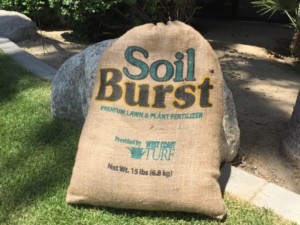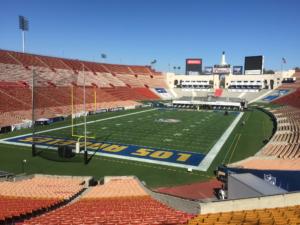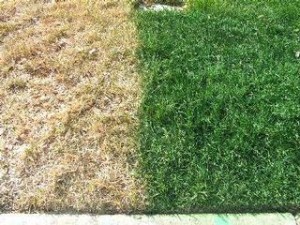Mar
When Should I Start to Spring Transition My Lawn to Bermudagrass?
I’d like to go over some common questions I have received through the blog in the last few weeks and see if it can help others with some of the same concerns. I always encourage everyone to send over your lawn questions and I will get back to you as soon as I can.
When should I start to transition my lawn back to bermudagrass?
I always recommend starting the process slowly in March and ramping up in April so your lawn has transitioned by May. I know that was a mouth full, but the truth is it’s not a short process unless you chemically transition your lawn. In March its ideal to start to gradually lower your mowing height and remove some of the turf canopy. This is not a scalp, this is lowering the height so the bermudagrass can breathe and get some sunlight. By mid-March you should be mowing two times per week and starting to see some thinning in the ryegrass. By thinning I mean bermudagrass leaves are starting to show between the ryegrass blades. Currently there is no need to fertilize the ryegrass, its time to back off on nutrition until bermudagrass season. In early April you can lightly verticut or even lightly power rake the lawn to remove some of the ryegrass giving way to bermudagrass. The more sunlight you can get in the grass, the faster you will transition. If the ryegrass remains extremely thick and lush you can expect it to provide excessive spring shade slowing down the bermudagrass. When soil temperatures reach 64 degrees (around April 15th) go ahead and apply ammonium sulfate 21-0-0 at 5 pounds per 1000 SF to jump start your bermudagrass. Continue mowing two times per week and gradually lowering your heights until you see the bermudagrass take over.
Spring Transition, keep lowering the height…..
Can I still put down pre-emergent for broadleaves?
Most of the grassy weeds and broadleaves are now germinating so putting down the preemergent will not yield the results you’re looking for. At this juncture its best to spot spray weeds depending on the type. Make sure the product is labeled for the weed you’re trying to control and can safely be used on bermudagrass. Grassy weeds use different chemicals than broadleaves and not all chemicals are safe and effective so check with specialty stores for better products.
What can I do to repair the urine damage from my dogs? Read the rest of this entry »
Comments Off on When Should I Start to Spring Transition My Lawn to Bermudagrass?Sep
Pre-Overseeding Tips for Your Lawn
I would like to start by congratulating everyone on making through another California and Arizona summer. I know we still have a couple months of triple digit temperatures, but the worst should be behind us at this point. As we move into September our morning temperatures will start to feel less painful, but remember your warm season grass is loving this weather–especially your California and Arizona sod. I have started to field questions regarding fall overseeding and I want to tell you to hit the brakes. Don’t just tap the brakes, slam on the brakes. You will see ryegrass hit the stores in the next week but walk away or buy it and sit on it until temperatures really drop. Today I want to discuss prep for the fall, and how to get your grass ready to overseed. This won’t be a tutorial on how to overseed, but instead some pointers of what to do before you overseed.
Comments Off on Pre-Overseeding Tips for Your LawnNov
You Have Overseeded Your California or Arizona Sod Lawn–Now What? And….Even if You Haven’t.
By now most of you who are going to overseed have either begun the process or have had your seed down for a few weeks. Today I want to discuss what to do now that you have the ryegrass growing and cooler temperatures are on the horizon.
Getting your ryegrass up and growing is obviously the first step to a successful winter lawn but what about maintenance? How can you make sure your ryegrass is strong going into the winter and you will have a full stand of ryegrass once the temperatures begin to drop into the 40’s at night? There are several key items associated with a strong winter lawn but early preparation should be high on your list.
Comments Off on You Have Overseeded Your California or Arizona Sod Lawn–Now What? And….Even if You Haven’t.Aug
Summer Tips for Your Sod Lawn in Arizona and California
Summer is wrapping up, the kids are heading back to school, and I’m sure you’re ready to come out of hibernation. While the summer heat is far from over in Arizona and California, it’s starting to become tolerable outside. With the slightly cooler mornings it’s time to get back outside and get your lawn ready for fall. Most people start thinking about overseeding their California and Arizona sod in September, but ideally you wouldn’t start the process until October when nighttime temperatures get into the 60’s. Between now and then there are some important steps you need to do to get your lawn ready and to save some headaches down the road.
Between May and September you probably noticed your lawn has grown at twice the rate it does during the winter months. Warm season grasses love the warm, wet weather. Most people thought the hot weather would keep the grass from growing well, but remember warm season grasses optimal growing temperatures are between 90-105 degrees. During this season any of your weaker areas should have filled in with the warm season grasses runners. These spots can be slow to fill in during the dry, hot days but as soon as the humidity kicks in the grass really takes off. If you still have large open spots I would suggest picking up a few rolls of sod and patching them prior to overseed. You don’t want to seed directly into the soil.
Comments Off on Summer Tips for Your Sod Lawn in Arizona and CaliforniaJun
The Benefits of Soil Burst Products
What is Soil Burst?

If you’re looking for a one-stop shop for plant fertilizer, then look no further. Soil Burst is a premium fertilizer for both plants and turf grass. It has a slow release formula that releases nitrogen into the soil in small doses over an extended period time rather than all at once. Perfect for any lawn stage, Soil Burst is customized to stimulate plant growth all year long. Read the rest of this entry »
Comments Off on The Benefits of Soil Burst ProductsDec
Winter Tips for Your Lawn
Cold temperatures have arrived in California and Arizona, and those of you with overseeded sod may begin to see your lawn go in a little shock. One of the things you will notice first is bermudagrass going dormant in the turf causing small quarter sized yellow spots in your lawn. This is nothing to be concerned about as today we will discuss getting those spots to fill in. If you didn’t overseed your lawn for the winter it’s most likely dormant at this point and you can sit back and let your lawn sleep for a few months.
I’m sure many of you have seen the small yellow spots over the years in your overseeded lawn. The question is what is causing it and what can you do about it? First, this isn’t something to be concerned about. It’s actually a sign that you had a very healthy lawn going into the overseed season. Since many people overseed in late September/early October you’re still fighting with warm season growth. By supplying water and fertilizer to overseed the bermudagrass continues to grow and has a tendency to out compete your newly seeded ryegrass. When you’re overseeded lawn first start growing it looks immaculate, but it’s good to remember some of this is bermudagrass. The bermudagrass/ryegrass combination looks incredible and when it’s growing in it can be tough to distinguish the two.
Comments Off on Winter Tips for Your LawnNov
Fall California and Arizona Lawn Tips!
It appears fall is never going to arrive as we’ve hit 90+ degrees twenty-three days in a row in the Phoenix area. The nighttime temperatures have slowly begun to cool but surprisingly they have yet to fall into the optimum range to overseed. For those who may have thought they were too late to drop seed, you still have a couple weeks to get your lawn going. Most people have already overseeded their lawns so I want to give some tips to assist your ryegrass while your warm season grass continues to grow.
If you overseeded anytime during the month of October I’m sure your lawn looks absolutely beautiful right now. It’s important to keep in mind that some of your grass is probably bermudagrass that bounced back from being scalped. How could this happen you ask? With daytime temperatures in the 90’s and nights in the 70’s it has allowed for an extended growing season. Many people including our sod farms use a turfgrass regulator such as Primo prior to scalping to help keep the bermudagrass in check. While this does help with a lot of the grow back it can’t prevent everything from coming back to life. Now that the ryegrass is up and growing strong it’s also a good time to put down a first or second application of Primo or other growth regulator. These products will greatly increase the density of your ryegrass and keep the bermudagrass from growing back. Why do you want to keep the bermudagrass out? If the bermudagrass is actively growing it is preventing your ryegrass from filling in completely. This is usually first observed after the first frost and the lawn will have small quarter size dormant turf spots throughout the turf. This is not a big deal as the ryegrass will eventually fill it in but something to keep in mind.
Comments Off on Fall California and Arizona Lawn Tips!Apr
April Lawn Transition Tips
For most parts of the country spring means a return to warmer temperatures and usually some good rain storms. For the desert southwest this typically means hot temperatures and the occasional rain event. We were lucky enough to get some late season El Niño storms this month which will have a nice impact on our warm season grasses.
The transition season has officially begun and over the next month you will start to see your underlying warm season grass start to push out the winter ryegrass. The hot temperatures will start to take their toll on the ryegrass and it will start to die out. It’s not uncommon to start to see dry patches emerge in your lawn that looked perfect the week prior.
As much as it may pain you to see sections of your beautiful lawn start to die back remember this is a good thing. Sections of your lawn will always dry out before others areas simply because of the soil texture, compaction, or sprinkler coverage. It’s important to rule out sprinkler issues and if it is merely a transition dry spot rest easy. For these spots I recommend taking a hard toothed rake and rake up the dead ryegrass that lies on the surface. This dead material is shading out the bermudagrass down below and preventing it from getting water and sunlight. Keeping your lawn mowed below ¾” during this time of the year and power raking or verticutting will also help remove dead material from shading your summer grass.
Comments Off on April Lawn Transition TipsNov
Tips On Maintaining Your Non-Overseeded Lawn This Winter
As we move through the fall season many of you will choose the option to forgo overseeding this season to save some water. With the prime growing season behind us you’re going to start to see your lawn start to slow down. The days are becoming shorter and your warm season grass is starting to need less inputs. There are a couple areas where you can cut back this winter to save yourself money. I will go into detail what you need to maintain a non-overseeded lawn during the winter, and go briefly over an overseeded lawn watering and fertilizer schedule.
My first suggestion for those that will not be overseeding is to turn your irrigation clock off except on the day you will be watering. Having your lawn set up to automatically run certain days and times during the fall/winter will cause you to use much more water than your lawn can utilize.
Comments Off on Tips On Maintaining Your Non-Overseeded Lawn This WinterSep
Fall Overseeding and Your Lawn
The days are getting shorter and the heat is starting to die down a little as we enter the fall season. With fall comes the onset of overseeding in many parts of the country and the West Coast is no different. For those new to overseeding let me give you a brief definition. Overseeding is simply the process of seeding a cool season grass into your warm season turfgrass in order to maintain winter color. This is not a mandatory process if you have grass, but it is one of the options that are out there for homeowners and professionals.
There are a few options during the fall months to take care of your lawn, and without question the most popular is to overseed. Outside of overseeding you have the option of using turf colorant such as Endurant to give your dormant grass a nice green appearance. Or you can just let your lawn go dormant for the winter months (brown can be the new green!). There is no right or wrong approach, so decide what you would like to do as the temperatures begin to drop over the coming weeks.
If you will be letting your lawn go dormant it will stay fairly green until the first hard frost which is around Thanksgiving and will start to green up in late March. If you have a paspalum lawn you can usually get through the month of December with a green lawn and it will start greening up in early March.
Comments Off on Fall Overseeding and Your Lawn








